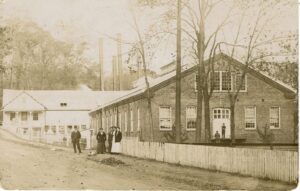
The Paper Mill Playhouse, a nonprofit theatre with nearly half a million yearly attendees and one of the largest subscription audiences in the United States, is one of Millburn’s most recognizable landmarks.
As its name suggests, the Playhouse began as a paper mill, one of several that were constructed in town along the Rahway River in the 18th and early 19th centuries. The site, purchased by Thistle Mill owner Samuel Campbell, was sold to Jonathan and Abraham Parkhurst in 1815, who built a binder board mill on the site five years later. In 1856, ownership passed to Israel D. Condit and in 1876 to the Diamond Mills Paper Company.
A successful manufacturer of colored tissue paper with 43 employees, the Diamond Mills Paper Mill and its adjacent pond figured prominently in early views of Millburn Township. Its closure in the early 20th century, due to declining business and shifts in manufacturing regulations, set the stage for a new phase of development. Nestled alongside the newly designated South Mountain Reservation and close to the Lackawanna train line, the old mill had just the type of “colonial charm” that poet and playwright Antoinette Scudder desired for her new theater.
In 1934, Scudder purchased the building and, with ample funding from her father’s newspaper fortune, converted the old Diamond Paper Mill into a state-of-the art theater. Together with Frank Carrington, she used their connections within the New York theatrical world to draw leading talent out to Millburn, New Jersey.
The Playhouse opened in 1938, with a performance of the play “The Kingdom of God”. In the years that followed, leading stars of stage and screen, including Irene Castle, Clarence Nordstrom, Basil Rathbone, Carol Channing, and Geraldine Page appeared at the Paper Mill Playhouse. By the 1960s, the Paper Mill Playhouse was a thriving hub of acting talent, featuring performers ranging from Betty White to Liza Minelli, Bert Parks to Mike Nichols.
In the 70s, then-governor William Cahill declared it the State Theater of New Jersey. After the passing of the original founders, Angelo del Rossi assumed the role of executive producer in 1975. He led the Playhouse in this position for nearly 30 years.
It seemed things couldn’t get better for the Playhouse. Unfortunately, on January 14, 1980, a fire once again tore through the Paper Mill gutting the theater. Pushing through costly rebuilding, the Playhouse was restored to its former glory- yet better. Del Rossi explained, “The moment I saw the fire, I said to myself: ‘We’re going to rebuild for keeps now.’” In 1982, it once again opened its doors, starting with an extravagant gala for longtime supporters featuring the musical Robert & Elizabeth.
The new theatre was vastly improved, now with accessible seating, infrared listening systems, and more. Just years later, the theatre was already back to its world-renowned status, ranking second in the nation by the National Endowment for the Arts for artistic excellence, second only to the Metropolitan Opera. PBS nationally aired productions of Showboat, opening the Paper Mill experience to tens of millions from their own homes.
By the end of the 80s, the Playhouse opened its education program. Since then, it has sported a large theatre school, nurturing hundreds of aspiring actors with alumni like Anne Hathaway and Rob McClure. The Paper Mill began hosting a Tony-style “Rising Star Award”, celebrating high school level stage actors from around New Jersey. Recently, the Paper Mill received the 2016 Regional Tony Award, given to the top regional theatre company in the country.
The Paper Mill Playhouse has stood in Millburn’s heart for years and years- from its beginnings as a mill over two centuries ago, through fire, conversion to a theater, and fire again, it has prevailed. It remains an iconic symbol of New Jersey and of its hometown, Millburn. It serves an annual audience of half a million, hosts a variety of education programs and is a center of downtown life. Through everything, the Paper Mill Playhouse still stands as one of Millburn’s proudest landmarks and continues to bring the community together with superb performances for young and old alike.